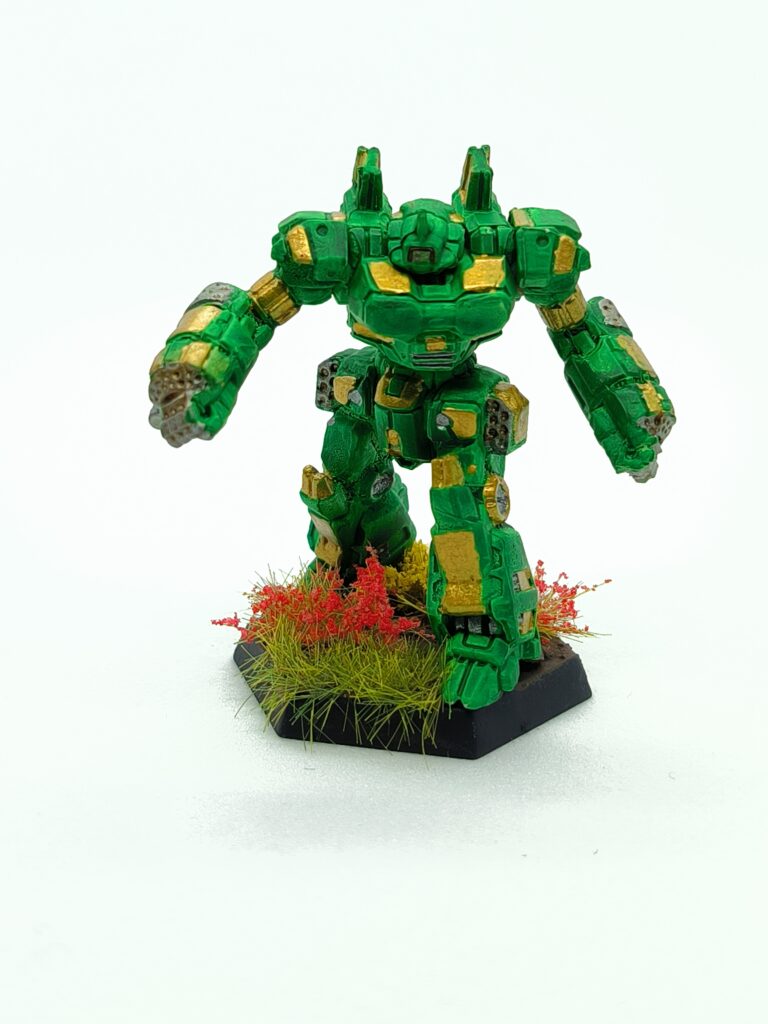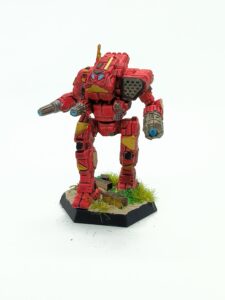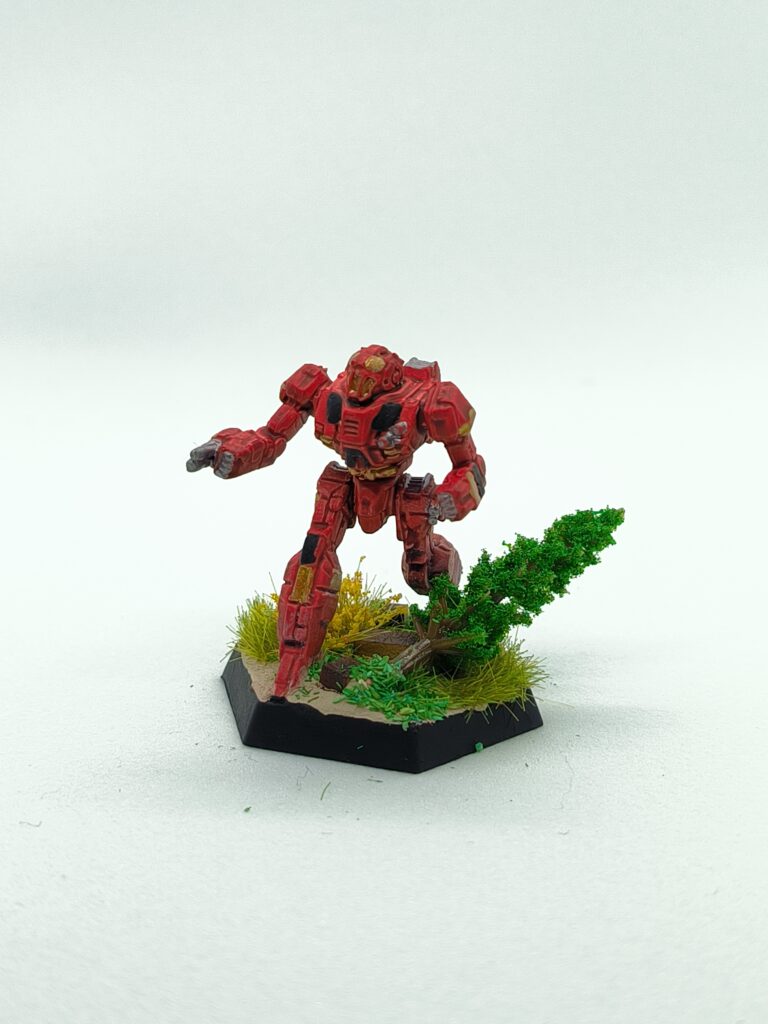Painting – Painting of the unit miniatures
Tips and tricks for painting BattleTech miniatures
Painting BattleTech miniatures is not only a creative process, but also really shows off your mechs – on the playing field and in the display case. With a little planning and patience, you can turn your miniatures into real eye-catchers.

Why painting miniature game figures is an integral part of the tabletop wargaming hobby
Tabletop wargaming, especially in the world of BattleTech Alpha Strike, is more than just playing on a table with dice and rules. It is an immersive hobby that combines creativity, strategy and social interaction. An important aspect of this hobby is painting the miniatures – an activity that many players see not just as an optional extra, but as a central part of the overall experience. But why is painting miniatures so important? Let’s take a closer look at the reasons.
1. Individual design and creativity
Painting miniatures offers a unique way to personalize your army. While BattleTech Alpha Strike offers standardized units and factions, painting your mechs allows you to create your own interpretation and vision of the characters. Whether you recreate the color schemes of official factions like the Wolf’s Dragoons or the Jade Falcons, or create your own completely original mercenary force, your miniatures will be unique.
This creative freedom makes the hobby even more fascinating. You can experiment with colors, shades, effects such as battle damage or weathering, so that each figure tells its own story.
2. Enhancement of the gaming experience
A painted miniature on a detailed gaming table takes the gaming experience to a whole new level. Instead of looking at gray plastic models, the game world comes to life: Units with glowing cockpit windows, battle damage and symbolic markings feel more real and draw players into the game’s story and strategy.
An example from BattleTech Alpha Strike: An urban battle between painted clan mechs and Inner Sphere units looks far more epic when the models wear the colors of their factions and the setting is visually appealing.
3. Sense of community and exchange
Painting miniatures is not just a solo activity. In the tabletop community, it is a popular topic of conversation and a central point of exchange. Many players proudly show off their painted figures on social media, at tournaments or in hobby stores. Sharing tips and techniques on how to implement color schemes or achieve realistic effects strengthens the sense of community and makes the hobby more accessible.
In many hobby stores and at BattleTech tournaments, there are often painting competitions or special prizes for the best painted armies. Such events not only promote creativity, but also the bond between players.
4. Stress reduction and artistic expression
Painting miniatures can also be a meditative and relaxing activity. For many, it is a way to escape the daily grind and focus fully on something crafty. The process of applying paint, perfecting the details and bringing the miniature to life offers a kind of creative balance.
Even if you are not an experienced artist, you can achieve impressive results with a little practice. Tutorials and beginner sets make it easy to get started and help you develop your own style.
5. Motivation to play
Nothing is more motivating to play a round of BattleTech Alpha Strike than a fully painted army. There is a deep sense of satisfaction when you place your troops on the field and know that every figure has been crafted with care and effort. This attachment to the miniatures can even influence the way you play: You may want to protect your units all the more after you’ve spent hours working on them!
Conclusion on the subject of painting BattleTech miniatures
Painting miniature figures is far more than just a decorative element in tabletop wargaming. It is a form of artistic expression, a way to intensify the gaming experience and a way to strengthen the community. Especially in the BattleTech Alpha Strike universe, painting offers the chance to bring the iconic mechs and factions to life in a very personal way.
Even if you’re new to the hobby, it’s worth taking the first steps. With a little practice and patience, you will not only improve your skills, but also gain a deeper understanding and greater enjoyment of this fascinating hobby.
With a little practice and the right resources, you’ll soon be putting impressive miniatures on the battlefield. Have fun painting them and remember: every mech tells its own story – through its color scheme, its details and the battles it fights!
So, grab your brushes, paints and mechs – and let your creativity run wild!
How do I paint BattleTech models for Alpha Strike? A guide
Tabletop wargaming is not only an exciting hobby, but also a creative form of expression. Especially in games such as BattleTech: Alpha Strike, where BattleMechs, vehicles and terrain elements are central elements, there is great appeal in individually painting and staging the models. But you don’t always have the time or patience to spend hours painting each model in detail. This is where Speedpaints come into play! They allow you to quickly achieve impressive results without sacrificing style and depth.
In this article, we will guide you step by step through the painting process – including tips on how you can work efficiently with Speedpaints without compromising on the look.
1. Preparation: the first step to success
Before the brushes are wielded, you should prepare the models carefully. Here are the most important steps:
Deburring and cleaning models
– Remove flash and excess material with a modeling knife or sandpaper. This is particularly important for the plastic and resin mechs from BattleTech so that the paint adheres evenly later on.
– Wash the miniatures with warm water and a little washing-up liquid to remove any production residue. Dry them thoroughly.
Assembly
– If your model consists of several parts (e.g. larger mechs or vehicles), glue them together with model making glue or superglue. Allow the glue to harden completely.
– Optional: Attach the miniatures to bases to make them easier to paint.
2. Primer: the basis for speedpaints and other techniques
A good primer is essential as it improves the adhesion of the paints and prepares the miniature for painting. Choosing the right primer is particularly important for Speedpaints, as these colors work best on light, neutral surfaces.

Selection of the primer color
– White or beige: The best choice for Speedpaints, as the light undertones make the colors bright and vibrant.
– Light gray: A good compromise if you prefer a subtle look.
– Ceniral highlighting: First spray the miniature in black and then apply a white or gray layer to the upper surfaces from an elevated position. This creates natural light and shadow effects, which are enhanced by Speedpaints.
3. Speedpaints: paint quickly and efficiently
Speedpaints (e.g. from The Army Painter or Citadel Contrast Paints) are special paints that combine wash, base color and shadow effects in one step. They flow into recesses and automatically create shading and highlights.
Advantages of Speedpaints
- Time saving: Ideal if you want to paint many models at once.
- Automatic shading: The colors create depth by themselves, without additional washes or highlighting.
- Easy to use: Perfect for beginners and advanced users.
Application of Speedpaints
1. Preparation of the colors: Shake the Speedpaints well, as the pigments can settle quickly.
2. Application: Apply the paint with a medium-sized brush. Do not paint over the same area too often, as this can affect the opacity.
3. Layering and drying: Allow each color to dry completely before applying another layer.
Color selection and color scheme
- Use Camo Specs Onlinea great resource for BattleTech fans. There you’ll find official color schemes for numerous factions, units and clans – perfect for giving your mech the right look.
- Alternatively, you can develop your own color scheme to give your mechs a personal touch.

Speedpaints are available in many variants. They are particularly suitable for BattleTech:
- Metallic tones for weapons and armor plates.
- Bright colors such as blue or red for clan or house mechs.
- Camouflage colors such as green, brown or grey for mercenary groups.
4. addition of classical painting techniques
Even though Speedpaints take a lot of the work out of painting, they can be perfectly combined with classic painting techniques to make your models stand out even more.
Dry brushing for accents
After applying the Speedpaints, you can lightly drybrush the raised areas with a lighter shade of paint. This increases the depth and highlights details such as armor grooves or weapon hulls.
Washes and highlights
Although Speedpaints already create shadows, you can apply washes to emphasize certain areas even more. For highlights, you can emphasize individual details, such as cockpits or edges, with lighter colors.
5. Paint details: Individuality for your mech
This is where the miniature comes to life. Concentrate on small, eye-catching details: Concentrate on small, eye-catching details:
- – Cockpit windows: Use bright colors such as blue or green and work in reflections with white.
- Weapons: Paint lasers, rocket launchers and machine guns in metallic colors.
- Markings and emblems: Use decals or paint them on freely. Clan or house logos give your mech character.
- Work in thin layers of paint so as not to obscure details. Apply several thin layers rather than one thick one.
- Set accents with highlights on raised edges to emphasize the details of the mech and create a realistic look.
6. Design terrain elements and bases
Speedpaints are not only suitable for miniatures – they also work great on terrain elements! Apply them to stones, wood or metal elements to achieve fast and realistic effects.
Ideas for bases
- Desert terrain: Paint the base with a sand-colored Speedpaint and add some dry grass.
- Urban ruins: Use gray and black Speedpaints to create concrete or asphalt effects.

7. Apply protective lacquer: For eternity
To protect your painting, apply a clear varnish:
– Matt lacquer: For a realistic finish.
– Gloss varnish: Ideal for metallic or glossy surfaces.
– Satin lacquer: A compromise between the two.
Speedpaints can be easily reactivated after drying if they come into contact with water or new layers of paint. A protective varnish reliably prevents this.
Conclusion: Painting made easy with Speedpaints
Speedpaints are a fantastic tool for painting BattleTech models quickly and effectively. Whether you’re preparing entire lances for the next Alpha Strike game or trying your hand at creative terrain pieces, these paints will save you time while offering impressive results. Combined with classic techniques like drybrushing and highlights, you can get the best out of your miniatures with minimal effort. So, give Speedpaints a try and make your BattleTech battlefields shine!
